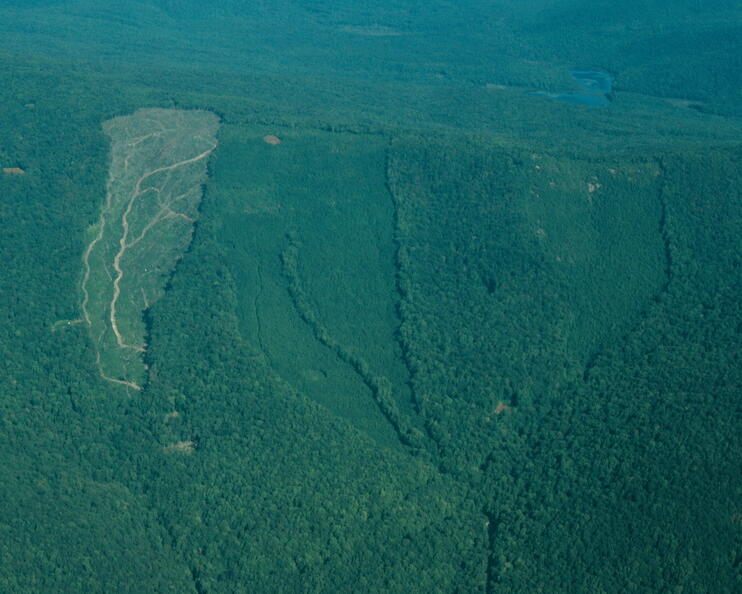In the White Mountains of New Hampshire, the streams are telling us a story about forest recovery following acid rain and logging. According to a new study in the Proceedings of the National Academy of Sciences, long-term watershed chemistry reveals that recovering forests are mining rocks for nutrients. While this leads to improved pH in nearby streams, it further depletes soils, leaving forests less resilient to future pollution.
The study team analyzed more than 60 years of data from the Hubbard Brook Experimental Forest, established by the US Forest Service in the 1950s for ecological and hydrologic research. Like much of the Northeast, the forest was heavily impacted by acid rain until the passage of the 1990 Clean Air Act Amendments. The three watersheds investigated included a watershed clear-cut in 1983 and then allowed to regrow, a watershed treated with calcium silicate in 1999 in an attempt to reverse the effects of acid rain, and a control watershed that only experienced the impacts of acid rain.

While reviewing data on the chemistry of the streams in these watersheds, the researchers discovered an unexpected result: Since 1987, the stream in the clear-cut watershed had been far less acidic than the neighboring control watersheds — despite having received identical inputs of acid rain.
“The stream in the clear-cut watershed was exporting much more silica and calcium out of its watershed than either of its neighbors. To put it in perspective, these re-growing forests released more calcium and silica over time than the watershed that had been treated with more than 100,000 pounds of pelletized calcium silicate. It was impressive to see this contrast in our data,” explains lead author Emily Bernhardt of Duke University.
Enhanced mineral mining: good for streams, bad for soils
Forests regrowing in the nutrient-depleted logged watershed were using their roots to mine minerals at an unexpected rate.
“Both timber harvest and acid rain have removed large amounts of nutrients from ecosystems,” says Bernhardt. “In places where both occurred, like the clear-cut watershed, regrowing trees are starved for the nutrients they need to grow, and they invest growth below ground to build roots and fuel microbes that can extract nutrients they need from underlying bedrock.”

Enhanced mineral weathering by the roots of trees like American beech sustains forests. When tree roots ‘mine’ apatite minerals for phosphorus, they also unlock less limiting nutrients like calcium and silicate, which are washed into nearby streams. Streams have improvements in pH, while soils experience decreasing fertility.
Loss of calcium and other nutrients from soils as a by-product of nutrient mining by trees compounds long-term losses of those nutrients from acid rain and deforestation, and may make these forests less resilient to future inputs of acid pollution from the atmosphere.
“Base cations like calcium help the forest soil to buffer inputs of acid precipitation,” says co-author Charles Driscoll of Syracuse University. “The loss of these nutrients means that these ecosystems are extremely vulnerable to any renewed input of acid from the burning of fossil fuels or other sources, or future harvesting.”
Maples replaced by beech
Since being logged in the 1980s, the clear-cut watershed has seen a major shift in tree species, with a steep decline in sugar maple and dominance of American beech, a species adept at mining minerals.
“The forest that is regrowing in the clear-cut watershed is not the same as the forest that was there previously, or the forests that still exist in nearby uncut watersheds,” says Bernhardt. “Sugar maple in particular has had difficulty re-growing in the nutrient-poor soils, and has been largely replaced by beech, which is vulnerable to beech leaf disease and beech bark disease.” Losses of sugar maple may be strongly felt in places like New Hampshire, where maple syrup production is an important part of the culture and economy.
Insights made possible by long-term monitoring
Long-term forest and watershed studies like Hubbard Brook are essential to understanding how environmental stressors — like acid rain, deforestation, and species shifts — play out over decades, and shape the health of forests and freshwaters. They also help us gauge the effectiveness of environmental policies and management practices.

The study is the first to show that ecosystem disturbances like acid rain and logging can enhance belowground weathering over a sustained period, with transformational impacts to the health of soils and adjacent streams. “The role of vegetation in releasing nutrients from rocks is well-known,” says Chris Solomon of Cary Institute of Ecosystem Studies, a co-author of the study. “But it’s unusual to have a data record long enough to observe these processes in action.”
Results of this unique long-term study suggest that throughout regions of the world affected by acid rain, the long-term legacy of deforestation is making regrowing forests increasingly vulnerable to future acidification.
Insights were made possible based on six decades of continuous measurements gathered by generations of scientists, with support from the National Science Foundation, the U.S. Forest Service, the Andrew Mellon Foundation, and the Alfred P. Sloan Foundation. Learn more and explore the record at hbwater.org






